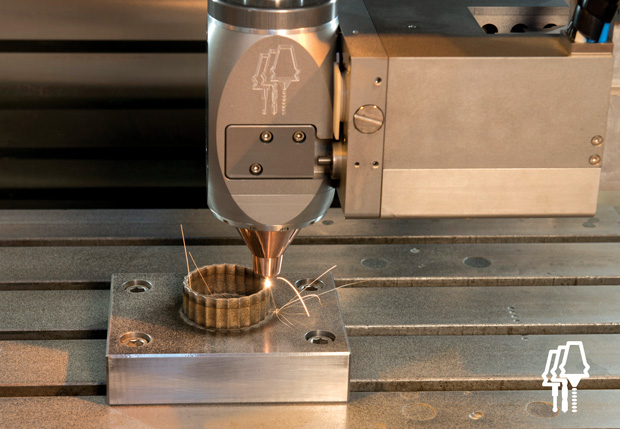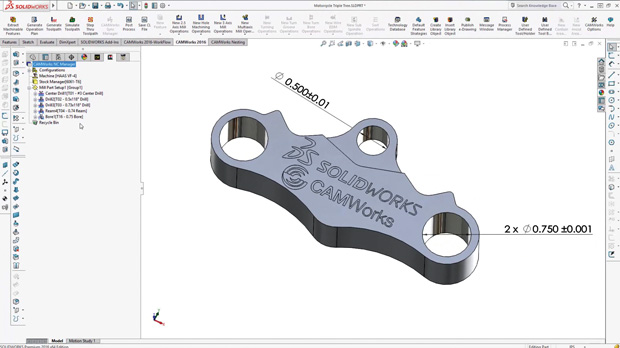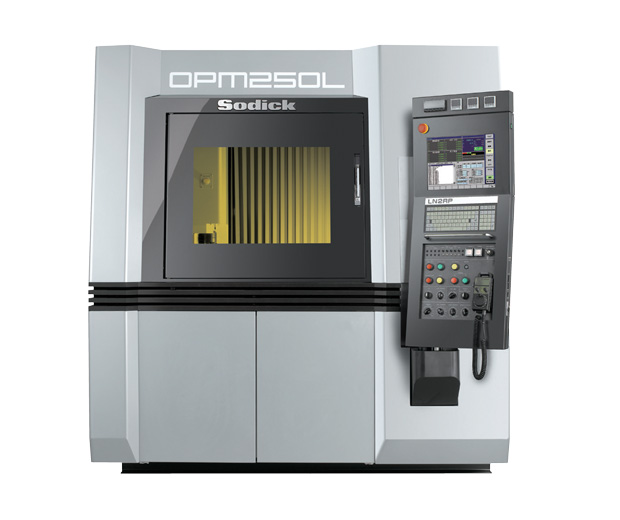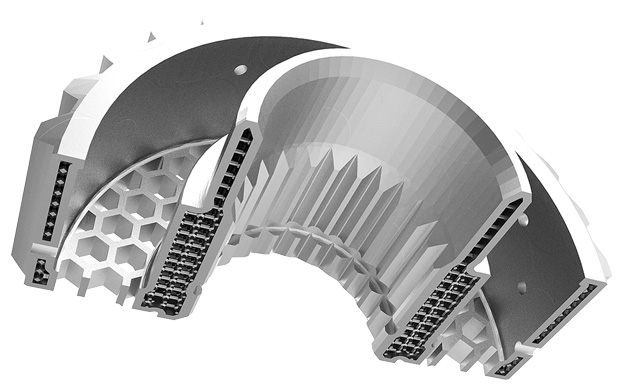Designing for the Future of Manufacturing

Depositing (via direct metal deposition) a scalloped boss on a part, which will then be machined to a fine finish using the AMBIT multi-task hybrid docking system from Hybrid Manufacturing Technologies. Image courtesy of Hybrid Manufacturing Technologies.
December 1, 2016
Just as you’re (perhaps) getting used to additive manufacturing (AM/3D printing) by understanding its capabilities and changing your design process to make the most of it, along come hybrid systems. Their varying approaches present intriguing considerations for adding AM technologies to a workflow. Some experts say this task will be straightforward, while others see the need for new software tools and thought processes.
 Depositing (via direct metal deposition) a scalloped boss on a part, which will then be machined to a fine finish using the AMBIT multi-task hybrid docking system from Hybrid Manufacturing Technologies. Image courtesy of Hybrid Manufacturing Technologies.
Depositing (via direct metal deposition) a scalloped boss on a part, which will then be machined to a fine finish using the AMBIT multi-task hybrid docking system from Hybrid Manufacturing Technologies. Image courtesy of Hybrid Manufacturing Technologies.For thousands of years, metal parts manufacturing has pretty much involved casting, die-casting, forging and/or machining. When engineers applied design-for-manufacturing (DFM) rules, they did so within with these well-understood processes. Now, to create parts that feature lower weight, sophisticated internal cooling, parts reduction, customized materials and faster handling, engineers also need to consider several distinct AM technologies—but that’s not the complete picture.
Producing finished parts still involves many steps, whether a part emerges as machined raw stock, built-up depositions or fused powder. Especially with layered manufacturing, most parts demand some type of secondary machining to remove support structures and/or create a finer surface finish. Then there may be cleaning, heat-treating, dimensioning—and of course, inspection. The fewer the separate steps, types of machinery and required handling, the faster, cheaper and more precise these parts can be. The solution may lie with hybrid AM/subtractive equipment.Most vendors in this growing field feel that orchestrating additive and subtractive steps within one system will require thoughtful planning. Before commanding the software to perform the right step at the right time, designers must identify which sections of a part should be “grown” and which require subtractive action. Autodesk’s Duann Scott, whose group targets business development and strategies for digital manufacturing, says that as designers begin to understand the potential, they will learn to define the surfaces that will interface with other parts and therefore are most likely to require subtractive work to create a fine surface finish.
 Example of building a part with laser deposition, then machining the features and surface finish, all done on the DMG MORI LASERTEC 65 3D hybrid additive manufacturing system. The 5-axis operation allows metal deposition to continue as the part is re-oriented. The image on the right shows that a second material (bronze) was deposited before the final machining. Image courtesy of DMG MORI USA.
Example of building a part with laser deposition, then machining the features and surface finish, all done on the DMG MORI LASERTEC 65 3D hybrid additive manufacturing system. The 5-axis operation allows metal deposition to continue as the part is re-oriented. The image on the right shows that a second material (bronze) was deposited before the final machining. Image courtesy of DMG MORI USA.“This often requires the design of a ‘near net shape’ part,” explains Scott, “with additional sacrificial material to be machined off in a secondary, subtractive process.” So, designers must develop knowledge of how much extra to add, and where, to accommodate this need. Scott says the tools for this are just emerging in software such as Netfabb (now an Autodesk product), to handle the complete DFM workflow—encompassing design, optimization, simulation of the build process (to predict thermal distortion), and subtractive post-processing.
At PTC, product manager Jose Coronado looks at this evolution as defining new rules of engagement. “In the past, engineers were trained to design for a set of manufacturing rules that remained stable,” he says. “Now, AM has come into play as an alternative for production, and many of those rules have changed.” Coronado notes, for example, that designers are not as worried about shape complexity because design freedom is a key benefit of this technology. However, they do still need to be careful about the build process as the support structures can be the tricky part.
A dramatic benefit of hybrid technology is elimination of support structures entirely if the part is properly oriented and built on a 5-axis machine. However, Coronado says the designer will require a different set of tools to appropriately define and simulate the sequence of growing and cutting steps. Creo 4.0, introduced with input from Stratasys, offers a starting point: Users can define the materials and colors a plastics 3D printer can handle in real time. In the future, such manufacturing awareness, embedded in the CAD system, can be expanded to cover the multi-processing capabilities of metal hybrid manufacturing.
Of course, most parts don’t exist in a vacuum; they are connected to one another via screws, bolts, gaskets, etc. Being able to evaluate dimensions mid-stream in an AM build would allow the machining part of the process to actively create the necessary flat mating surfaces or even datum for precise alignments. A first step toward adding this feature to hybrid systems is underway, as developers at Dassault Systèmes SOLIDWORKS have teamed up with Geometric Americas to offer CAMWorks software.
Craig Therrien, SOLIDWORKS product manager, says the latest version of Geometric CAMWorks, embedded in SOLIDWORKS, introduces “tolerance-based machining” into traditional CNC (computer numerically controlled) systems. This capability reads SOLIDWORKS model-based definition (MBD) dimensional information, selects machining strategies, machines to the mean of asymmetric tolerances and selects appropriate tools, feeds and speeds. Therrien can envision how in-process machining would save time and improve accuracy on hybrid AM/subtractive systems, when expert MBD information is used to automatically generate CNC programs meeting specified requirements.
 Geometric CAMWorks, embedded within SOLIDWORKS, reads 3D CAD model dimension tolerancing then selects machining strategies and tools for part production. This capability will be extended to operate with hybrid AM/subtractive systems. Image courtesy of Dassault Systèmes SOLIDWORKS.
Geometric CAMWorks, embedded within SOLIDWORKS, reads 3D CAD model dimension tolerancing then selects machining strategies and tools for part production. This capability will be extended to operate with hybrid AM/subtractive systems. Image courtesy of Dassault Systèmes SOLIDWORKS.Working with Hybrid Powder-Bed Systems in Manufacturing
You don’t have to wait to install combined additive/subtractive tools on your manufacturing floor. More than eight systems are already for sale, with additional options available for build-your-own; all are based either on power-bed laser sintering or direct metal deposition, but vary in the details. Their developers, ranging from familiar AM businesses to traditional CNC equipment providers, are ready to share what designers need to know.
Additive Industries and Sodick have both combined powder-bed AM part production with features that simplify post-processing or in-process steps. The MetalFab 1 from Additive Industries performs automatic powder removal in the same unit, stores eight empty build plates internally, and offers inline stress-relieving heat treatment up to 1100°C. Daan Kersten, co-founder and CEO, says in the future they will include automatic part removal, integration with machining and fast material change-outs. In terms of preparation, he says designers need to know the surface roughness and tolerances to define what areas can be printed and which need subtractive post-processing. “The same goes for material characteristics,” Kersten says. “The designer should know what properties the material should have and thus whether heat treatment is needed.” Also, knowledge of CAM programming is important, though designers will benefit when smart products such as exaSIM build-simulation software from 3DSIM come into use.
Sodick, a 40-year veteran of electronic discharge machining (EDM) equipment, has applied its rigid linear-motor expertise to produce what it calls the One-Process Machine (OPM) 250L metal 3D printer. This system combines metal laser powder-bed sintering and high speed milling in the same workspace, offering designers the ability to create deep, finished internal cuts during a build that would otherwise be impossible to reach. The target usage is adding conformal cooling inside a single-piece mold.
 Sodick’s OPM250L introduces a 45,000 RPM mill during the sintering process within the same machine. Image courtesy of Sodick.
Sodick’s OPM250L introduces a 45,000 RPM mill during the sintering process within the same machine. Image courtesy of Sodick.To help designers make the most of this hybrid system, the company offers OS-FLASH control software designed specifically for the OPM, says Evan Syverson, marketing manager at Sodick. “Our software offers what you would expect from [standard] CAM software,” he explains, “but it can optimize the tool path, adjust the feed rate and simulate the build to predict build time. If you have milling experience, it should not be particularly hard to program.” Tools are mounted in a 16-position automatic tool changer. OS-FLASH defaults to building 10 layers at a time, then milling, but designers can change this value.
Direct Metal Deposition
Having decades of experience with direct metal deposition (DMD) systems, Optomec is in a great position to guide users transitioning from traditional manufacturing to additive and hybrid processing. “The jump to total additive design approaches (e.g., skeletal structures) is very ‘disruptive’ and requires a totally new mindset and approach,” says Tom McDonald, senior program manager for LENS at Optomec. “Hybrid AM, as recently introduced by Optomec, represents a pathway for ‘evolutionary’ barrier reduction related to equipment cost and a familiar, user-friendly CNC platform,” he says.Launched at the 2016 International Manufacturing Technology Show, Optomec’s new LENS Machine Tool Series integrates LENS DMD technology with conventional CNC vertical machining center (VMC) platforms and control software. Three models offer the choice of pure metal DMD, metal hybrid DMD/VMC or metal hybrid VMC with inert capabilities (the latter for depositing reactive metals and aluminum). With the hybrid capabilities, explains McDonald, you don’t need to totally rethink the part—the CAD is still the same—but you remove the access restrictions that previously dictated building that part as an assembly. “Your mindset can still be subtractive,” he notes, “but you’re only building the shape that you require, or adding features to an existing part; you have total freedom of orientation to optimize the subtractive component.” The company is also working with Autodesk, an Optomec investor, to demonstrate fully integrated CAD/CAM solutions.
It’s equally interesting to see the viewpoint of a player that is relatively new to AM but has expertise in milling and multi-axis machining equipment that dates back almost 150 years: DMG MORI USA. Two years ago the company launched its LASERTEC 65 “all-in-one” laser deposition welding and 5-axis milling system, followed last year by the LASERTEC 4300; the latter system features integrated 6-sided turn-and-mill complete machining and almost three times the build-volume.
 Example of a complex part with internal structures that can be built on the MetalFab1 from Additive Industries. This AM equipment includes automatic powder-removal and in-line stress-relieving heat treatment—another angle to offering hybrid functions in a single AM system. Image courtesy Additive Industries.
Example of a complex part with internal structures that can be built on the MetalFab1 from Additive Industries. This AM equipment includes automatic powder-removal and in-line stress-relieving heat treatment—another angle to offering hybrid functions in a single AM system. Image courtesy Additive Industries.The company has been investigating this field for some time, watching the split between AM for rapid prototyping and AM for production applications in terms of what drives the designs and where a hybrid approach is compelling, says Greg Hyatt, senior vice president and CTO, Advanced Solutions Development at DMG MORI USA. Citing the now-famous example of the GE Aerospace fuel nozzle designed for AM, Hyatt notes: “They took an assembly of parts and built it as a single part. In so doing they eliminated the flanges between parts, eliminated assembly time and eliminated the need for wrench clearance to assemble the parts—fantastic benefits. But, there are very few cases where you can take an entire assembly and combine it into a single build without inadvertently trapping critical features that have to be machined somewhere deep in the core of the part.” A hybrid solution is essential to perform that mid-build machining.
This thought leads to observations about what Hyatt calls “the conventional approach” in today’s AM world, where a part is built by material deposition and then moved to a traditional machining center. “As a general rule, this [process] does not support the consolidation of entire assemblies into a single build,” he says. Also, most assemblies are not made of the same alloy, so the system has to be able to change alloys dynamically during the build. Machines that can support mid-process machining and dynamic change of alloys, adds Hyatt, are more expensive and more difficult to program than the simpler machines, but are almost essential for parts that are designed for the added freedom of AM.
Equally intriguing is a flexible system from a company founded specifically to develop hybrid additive/subtractive capabilities. Hybrid Manufacturing Technologies began offering its AMBIT multi-task system in 2013, and by 2015 was the inaugural winner of the International Additive Manufacturing Award. The AMBIT system comprises a series of metal deposition heads and docking systems that allows virtually any CNC machine or robotic platform to support automated change overs including non-traditional tools. Currently the system supports 3D deposition, cladding, marking, cutting, drilling, pre-heating, annealing/stress-relieving, surface re-melting, cleaning and in-process inspection.
For efficient use of these options, the entire part does not need to be made using only AM, says Jason Jones, CEO and co-founder of Hybrid Manufacturing Technologies. “For example,” he explains, “parts can start as castings, forgings or machined billets, and then various features can be added onto them.”
To design for an AMBIT-enabled system, “Designers should be well versed in conventional machining as well as the additional requirements of AM; e.g., the proposed geometry should be self-supporting, as dictated by the possible build orientations given the number of axes of the host CNC system,” says Jones.
“They (designers) need to be mindful that for features that are added, both the composition and microstructure are determined as the material is added.” With hybrid capabilities beginning to appear in mainstream CAM software packages, Jones observes, “At present, the processing sequence is determined by an operator well versed in CAM; however, the future promises to automate process routing.”
Stay Tuned for More
The number of companies seeing advantages with hybrid systems continues to grow. Mazak USA now markets the 5-axis INTEGREX i-400AM DMD system that it says is perfect for small lot production of very difficult-to-cut materials. Fryer Machine Systems includes an Optomec LENS DMD print engine in its new LaserFab hybrid machining unit. And Matsuura Machinery’s LUMEX Avance-25 alternates powder-bed laser sintering with 20-tool machining, working with such materials as steels, cobalt chrome, nickel alloys and, with the proper gas atmosphere, titanium. Watch for new design rules as all these systems make their way to the manufacturing floor.
For more information on designing for additive manufacturing, check out this series of videos from ASME:
https://www.youtube.com/watch?v=mDRCP3TkF0E&list=PLcJsb0AmPT9A1qv506kscMxI_0uVoQuJx
More Info
Subscribe to our FREE magazine, FREE email newsletters or both!
About the Author
Pamela Waterman worked as Digital Engineering’s contributing editor for two decades. Contact her via .(JavaScript must be enabled to view this email address).
Follow DE





